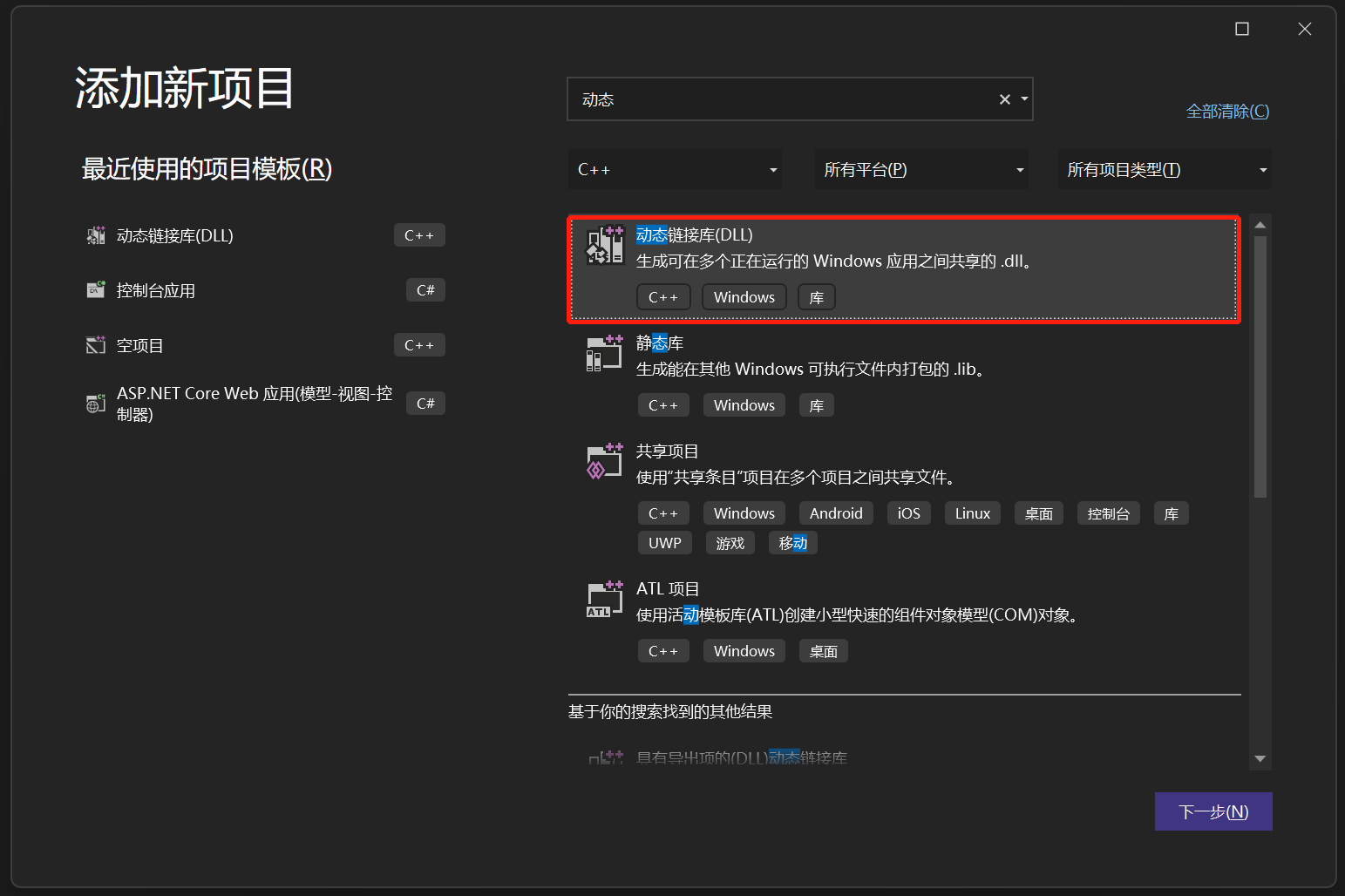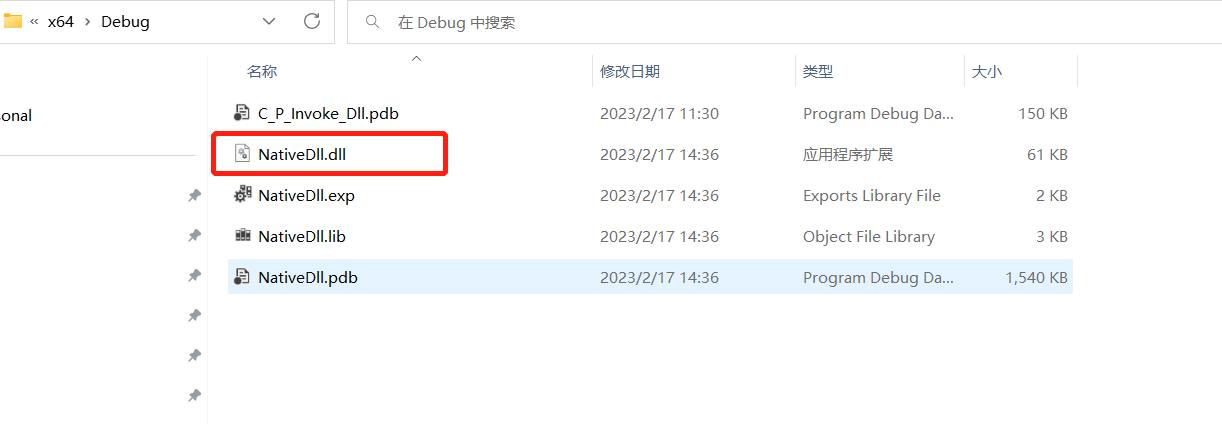P/Invoke之C#呼叫動態連結庫DLL
本編所涉及到的工具以及框架:
1、Visual Studio 2022
2、.net 6.0
P/Invok是什麼?
P/Invoke全稱為Platform Invoke(平臺呼叫),其實際上就是一種函數呼叫機制,通過P/Invoke就可以實現呼叫非託管Dll中的函數。
在開始之前,我們首先需要了解C#中有關託管與非託管的區別
託管(Collocation),即在程式執行時會自動釋放記憶體;
非託管,即在程式執行時不會自動釋放記憶體。
廢話不多說,直接實操
第一步:
-
開啟VS2022,新建一個C#控制檯應用

-
右擊解決方案,新增一個新建項,新建一個"動態連結庫(DLL)",新建完之後需要右擊當前專案--> 屬性 --> C/C++ --> 預編譯頭 --> 選擇"不使用編譯頭"

-
在新建的DLL中我們新建一個標頭檔案,用於編寫我們的方法定義,然後再次新建一個C++檔案,字尾以.c 結尾

第二步:
-
在我們DLL中的標頭檔案(Native.h)中定義相關的Test方法,具體程式碼如下:
#pragma once // 定義一些宏 #ifdef __cplusplus #define EXTERN extern "C" #else #define EXTERN #endif #define CallingConvention _cdecl // 判斷使用者是否有輸入,從而定義區分使用dllimport還是dllexport #ifdef DLL_IMPORT #define HEAD EXTERN __declspec(dllimport) #else #define HEAD EXTERN __declspec(dllexport) #endif HEAD int CallingConvention Sum(int a, int b); -
之後需要去實現標頭檔案中的方法,在Native.c中實現,具體實現如下:
#include "Native.h" // 匯入頭部檔案 #include "stdio.h" HEAD int Add(int a, int b) { return a+b; } -
在這些步驟做完後,可以嘗試生成解決方案,檢查是否報錯,沒有報錯之後,將進入專案檔案中,檢查是否生成DLL (../x64/Debug)

第三步:
-
在這裡之後,就可以在C#中去嘗試呼叫剛剛所宣告的方法,以便驗證是否呼叫DLL成功,其具體實現如下:
using System.Runtime.InteropServices; class Program { [DllImport(@"C:\My_project\C#_Call_C\CSharp_P_Invoke_Dll\x64\Debug\NativeDll.dll")] public static extern int Add(int a, int b); public static void Main(string[] args) { int sum = Add(23, 45); Console.WriteLine(sum); Console.ReadKey(); } }執行結果為:
68,證明我們成功呼叫了DLL動態鏈庫
C#中通過P/Invoke呼叫DLL動態鏈庫的流程
通過上述一個簡單的例子,我們大致瞭解到了在C#中通過P/Invoke呼叫DLL動態鏈庫的流程,接下我們將對C#中的程式碼塊做一些改動,便於維護
-
在改動中我們將用到
NativeLibrary類中的一個方法,用於設定回撥,解析從程式集進行的本機庫匯入,並實現通過設定DLL的相對路徑進行載入,其方法如下:public static void SetDllImportResolver (System.Reflection.Assembly assembly, System.Runtime.InteropServices.DllImportResolver resolver); -
在使用這個方法前,先檢視一下其引數
a、assembly: 主要是獲取包含當前正在執行的程式碼的程式集(不過多講解)
b、resolber: 此引數是我們要注重實現的,我們可以通過檢視他的元程式碼,發現其實現的是一個委託,因此我們對其進行實現。
原始方法如下:public delegate IntPtr DllImportResolver(string libraryName, Assembly assembly, DllImportSearchPath? searchPath); -
實現resolver方法:
const string NativeLib = "NativeDll.dll"; static IntPtr DllImportResolver(string libraryName, Assembly assembly, DllImportSearchPath? searchPath) { string dll = Path.Combine(new DirectoryInfo(Environment.CurrentDirectory).Parent.Parent.Parent.Parent.ToString(), "x64","Release", "NativeDll.dll"); // 此處為Dll的路徑 //Console.WriteLine(dll); return libraryName switch { NativeLib => NativeLibrary.Load(dll, assembly, searchPath), _ => IntPtr.Zero }; }該方法主要是用於區分在載入DLL時不一定只能是設定絕對路徑,也可以使用相對路徑對其載入,本區域程式碼是通過使用委託去實現載入相對路徑對其DLL載入,這樣做的好處是,便於以後需要更改DLL的路徑時,只需要在這個方法中對其相對路徑進行修改即可。
-
更新C#中的程式碼,其程式碼如下:
using System.Reflection; using System.Runtime.InteropServices; class Program { const string NativeLib = "NativeDll.dll"; [DllImport(NativeLib)] public static extern int Add(int a, int b); static IntPtr DllImportResolver(string libraryName, Assembly assembly, DllImportSearchPath? searchPath) { string dll = Path.Combine(new DirectoryInfo(Environment.CurrentDirectory).Parent.Parent.Parent.Parent.ToString(), "x64","Release", "NativeDll.dll"); Console.WriteLine(dll); return libraryName switch { NativeLib => NativeLibrary.Load(dll, assembly, searchPath), _ => IntPtr.Zero }; } public static void Main(string[] args) { NativeLibrary.SetDllImportResolver(Assembly.GetExecutingAssembly(), DllImportResolver); int sum = Add(23, 45); Console.WriteLine(sum); Console.ReadKey(); } } -
最後重新編譯,檢查其是否能順利編譯通過,最終我們的到的結果為:
68
至此,我們就完成了一個簡單的C#呼叫動態連結庫的案例
下面將通過一個具體範例,講述為什麼要這樣做?(本範例通過從效能方面進行對比)
-
在DLL中的標頭檔案中,加入如下程式碼:
HEAD void CBubbleSort(int* array, int length); -
在.c檔案中加入如下程式碼:
HEAD void CBubbleSort(int* array, int length) { int temp = 0; for (int i = 0; i < length; i++) { for (int j = i + 1; j < length; j++) { if (array[i] > array[j]) { temp = array[i]; array[i] = array[j]; array[j] = temp; } } } } -
C#中的程式碼修改:
using System.Diagnostics; using System.Reflection; using System.Runtime.InteropServices; class Program { const string NativeLib = "NativeDll.dll"; [DllImport(NativeLib)] public unsafe static extern void CBubbleSort(int* arr, int length); static IntPtr DllImportResolver(string libraryName, Assembly assembly, DllImportSearchPath? searchPath) { string dll = Path.Combine(new DirectoryInfo(Environment.CurrentDirectory).Parent.Parent.Parent.Parent.ToString(), "x64", "Release", "NativeDll.dll"); //Console.WriteLine(dll); return libraryName switch { NativeLib => NativeLibrary.Load(dll, assembly, searchPath), _ => IntPtr.Zero }; } public unsafe static void Main(string[] args) { int num = 1000; int[] arr = new int[num]; int[] cSharpResult = new int[num]; //隨機生成num數量個(0-10000)的數位 Random random = new Random(); for (int i = 0; i < arr.Length; i++) { arr[i] = random.Next(10000); } //利用氣泡排序對其陣列進行排序 Stopwatch sw = Stopwatch.StartNew(); Array.Copy(arr, cSharpResult, arr.Length); cSharpResult = BubbleSort(cSharpResult); Console.WriteLine($"\n C#實現排序所耗時:{sw.ElapsedMilliseconds}ms\n"); // 呼叫Dll中的氣泡排序演演算法 NativeLibrary.SetDllImportResolver(Assembly.GetExecutingAssembly(), DllImportResolver); fixed (int* ptr = &arr[0]) { sw.Restart(); CBubbleSort(ptr, arr.Length); } Console.WriteLine($"\n C實現排序所耗時:{sw.ElapsedMilliseconds}ms"); Console.ReadKey(); } //氣泡排序演演算法 public static int[] BubbleSort(int[] array) { int temp = 0; for (int i = 0; i < array.Length; i++) { for (int j = i + 1; j < array.Length; j++) { if (array[i] > array[j]) { temp = array[i]; array[i] = array[j]; array[j] = temp; } } } return array; } } -
執行結果:
C#實現排序所耗時: 130ms C實現排序所耗時:3ms在實現本案例中,可能在編譯後,大家所看到的結果不是很出乎意料,但這只是一種案例,希望通過此案例的分析,能給大家帶來一些意想不到的收穫叭。
最後
簡單做一下總結叭,通過上述所描述的從第一步如何建立一個DLL到如何通過C#去呼叫的一個簡單範例,也應該能給正在查閱相關資料的你有所收穫,也希望能給在這方面有所研究的你有一些相關的啟發,同時也希望能給目前對這方面毫無瞭解的你有一個更進一步的學習。
作者:百寶門-劉忠帥
原文地址:https://blog.baibaomen.com/p-invoke之c呼叫動態連結庫dll/